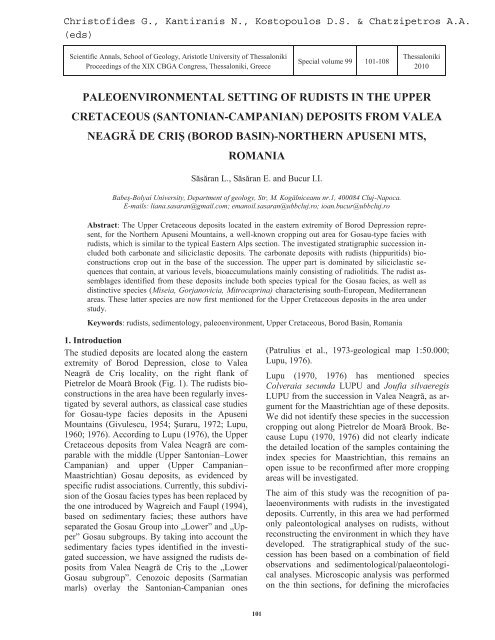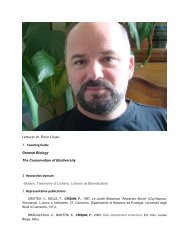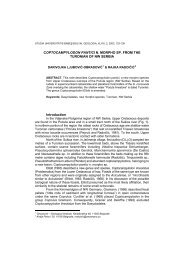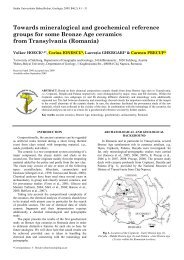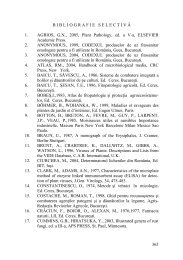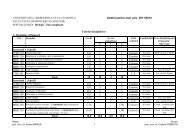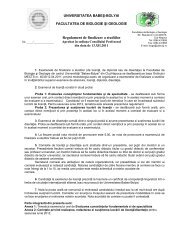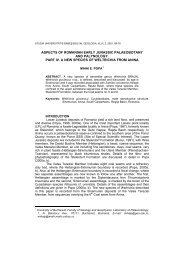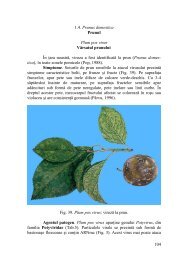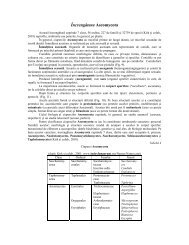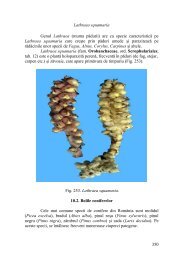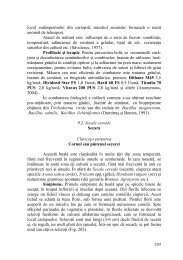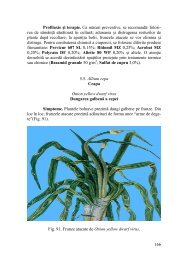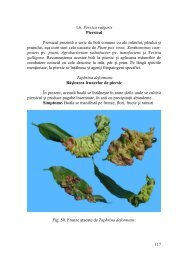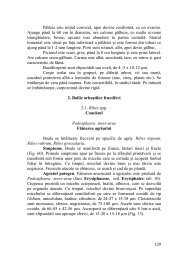paleoenvironmental setting of rudists in the upper cretaceous
paleoenvironmental setting of rudists in the upper cretaceous
paleoenvironmental setting of rudists in the upper cretaceous
You also want an ePaper? Increase the reach of your titles
YUMPU automatically turns print PDFs into web optimized ePapers that Google loves.
Scientific Annals, School <strong>of</strong> Geology, Aristotle University <strong>of</strong> Thessaloniki<br />
Proceed<strong>in</strong>gs <strong>of</strong> <strong>the</strong> XIX CBGA Congress, Thessaloniki, Greece<br />
101<br />
Special volume 99 101-108<br />
Thessaloniki<br />
2010<br />
PALEOENVIRONMENTAL SETTING OF RUDISTS IN THE UPPER<br />
CRETACEOUS (SANTONIAN-CAMPANIAN) DEPOSITS FROM VALEA<br />
NEAGRĂ DE CRIŞ (BOROD BASIN)-NORTHERN APUSENI MTS,<br />
ROMANIA<br />
Săsăran L., Săsăran E. and Bucur I.I.<br />
Babeş-Bolyai University, Department <strong>of</strong> geology, Str, M. Kogălniceanu nr.1, 400084 Cluj-Napoca.<br />
E-mails: liana.sasaran@gmail.com; emanoil.sasaran@ubbcluj.ro; ioan.bucur@ubbcluj.ro<br />
Abstract: The Upper Cretaceous deposits located <strong>in</strong> <strong>the</strong> eastern extremity <strong>of</strong> Borod Depression represent,<br />
for <strong>the</strong> Nor<strong>the</strong>rn Apuseni Mounta<strong>in</strong>s, a well-known cropp<strong>in</strong>g out area for Gosau-type facies with<br />
<strong>rudists</strong>, which is similar to <strong>the</strong> typical Eastern Alps section. The <strong>in</strong>vestigated stratigraphic succession <strong>in</strong>cluded<br />
both carbonate and siliciclastic deposits. The carbonate deposits with <strong>rudists</strong> (hippuritids) bioconstructions<br />
crop out <strong>in</strong> <strong>the</strong> base <strong>of</strong> <strong>the</strong> succession. The <strong>upper</strong> part is dom<strong>in</strong>ated by siliciclastic sequences<br />
that conta<strong>in</strong>, at various levels, bioaccumulations ma<strong>in</strong>ly consist<strong>in</strong>g <strong>of</strong> radiolitids. The rudist assemblages<br />
identified from <strong>the</strong>se deposits <strong>in</strong>clude both species typical for <strong>the</strong> Gosau facies, as well as<br />
dist<strong>in</strong>ctive species (Miseia, Gorjanovicia, Mitrocapr<strong>in</strong>a) characteris<strong>in</strong>g south-European, Mediterranean<br />
areas. These latter species are now first mentioned for <strong>the</strong> Upper Cretaceous deposits <strong>in</strong> <strong>the</strong> area under<br />
study.<br />
Keywords: <strong>rudists</strong>, sedimentology, paleoenvironment, Upper Cretaceous, Borod Bas<strong>in</strong>, Romania<br />
1. Introduction<br />
The studied deposits are located along <strong>the</strong> eastern<br />
extremity <strong>of</strong> Borod Depression, close to Valea<br />
Neagră de Criş locality, on <strong>the</strong> right flank <strong>of</strong><br />
Pietrelor de Moară Brook (Fig. 1). The <strong>rudists</strong> bioconstructions<br />
<strong>in</strong> <strong>the</strong> area have been regularly <strong>in</strong>vestigated<br />
by several authors, as classical case studies<br />
for Gosau-type facies deposits <strong>in</strong> <strong>the</strong> Apuseni<br />
Mounta<strong>in</strong>s (Givulescu, 1954; Şuraru, 1972; Lupu,<br />
1960; 1976). Accord<strong>in</strong>g to Lupu (1976), <strong>the</strong> Upper<br />
Cretaceous deposits from Valea Neagră are comparable<br />
with <strong>the</strong> middle (Upper Santonian–Lower<br />
Campanian) and <strong>upper</strong> (Upper Campanian–<br />
Maastrichtian) Gosau deposits, as evidenced by<br />
specific rudist associations. Currently, this subdivision<br />
<strong>of</strong> <strong>the</strong> Gosau facies types has been replaced by<br />
<strong>the</strong> one <strong>in</strong>troduced by Wagreich and Faupl (1994),<br />
based on sedimentary facies; <strong>the</strong>se authors have<br />
separated <strong>the</strong> Gosau Group <strong>in</strong>to „Lower” and „Upper”<br />
Gosau subgroups. By tak<strong>in</strong>g <strong>in</strong>to account <strong>the</strong><br />
sedimentary facies types identified <strong>in</strong> <strong>the</strong> <strong>in</strong>vestigated<br />
succession, we have assigned <strong>the</strong> <strong>rudists</strong> deposits<br />
from Valea Neagră de Criş to <strong>the</strong> „Lower<br />
Gosau subgroup”. Cenozoic deposits (Sarmatian<br />
marls) overlay <strong>the</strong> Santonian-Campanian ones<br />
(Patrulius et al., 1973-geological map 1:50.000;<br />
Lupu, 1976).<br />
Lupu (1970, 1976) has mentioned species<br />
Colveraia secunda LUPU and Joufia silvaeregis<br />
LUPU from <strong>the</strong> succession <strong>in</strong> Valea Neagră, as argument<br />
for <strong>the</strong> Maastrichtian age <strong>of</strong> <strong>the</strong>se deposits.<br />
We did not identify <strong>the</strong>se species <strong>in</strong> <strong>the</strong> succession<br />
cropp<strong>in</strong>g out along Pietrelor de Moară Brook. Because<br />
Lupu (1970, 1976) did not clearly <strong>in</strong>dicate<br />
<strong>the</strong> detailed location <strong>of</strong> <strong>the</strong> samples conta<strong>in</strong><strong>in</strong>g <strong>the</strong><br />
<strong>in</strong>dex species for Maastrichtian, this rema<strong>in</strong>s an<br />
open issue to be reconfirmed after more cropp<strong>in</strong>g<br />
areas will be <strong>in</strong>vestigated.<br />
The aim <strong>of</strong> this study was <strong>the</strong> recognition <strong>of</strong> palaeoenvironments<br />
with <strong>rudists</strong> <strong>in</strong> <strong>the</strong> <strong>in</strong>vestigated<br />
deposits. Currently, <strong>in</strong> this area we had performed<br />
only paleontological analyses on <strong>rudists</strong>, without<br />
reconstruct<strong>in</strong>g <strong>the</strong> environment <strong>in</strong> which <strong>the</strong>y have<br />
developed. The stratigraphical study <strong>of</strong> <strong>the</strong> succession<br />
has been based on a comb<strong>in</strong>ation <strong>of</strong> field<br />
observations and sedimentological/palaeontological<br />
analyses. Microscopic analysis was performed<br />
on <strong>the</strong> th<strong>in</strong> sections, for def<strong>in</strong><strong>in</strong>g <strong>the</strong> micr<strong>of</strong>acies
types; polished slabs have been used for <strong>rudists</strong>’<br />
identification. The characteristic features <strong>of</strong> <strong>the</strong><br />
rudist associations were used for bi<strong>of</strong>acies <strong>in</strong>terpretation.<br />
By corroborat<strong>in</strong>g paleontological, micr<strong>of</strong>acies,<br />
sedimentological and biostratigraphical<br />
data, we could propose <strong>the</strong> <strong>paleoenvironmental</strong> reconstruction<br />
for <strong>the</strong> Upper Cretaceous <strong>in</strong> <strong>the</strong> study<br />
area.<br />
Fig. 1. Location <strong>of</strong> <strong>the</strong> studied area. Legend: 1-Magmatic<br />
rocks; 2-Proterozoic rocks (Seria de Somes); 3-Triassic<br />
deposits; 4-Jurassic deposits; 5-Upper Cretaceous<br />
deposits; 6-Miocene deposits; 7-Quaternary deposits;<br />
8-location <strong>of</strong> <strong>the</strong> sedimentologic log <strong>in</strong> <strong>the</strong> Upper Cretaceous<br />
deposits from Valea Neagră de Criş.<br />
2. Stratigraphy and sedimentary facies<br />
The Upper Cretaceous deposits <strong>in</strong> Gosau facies<br />
along <strong>the</strong> right flank <strong>of</strong> Pietrelor de Moară Brook<br />
crop out along a stratigraphical succession <strong>of</strong> about<br />
45 meters thick. The lower part <strong>of</strong> <strong>the</strong> pr<strong>of</strong>ile is<br />
characterized by an alternation <strong>of</strong> conglomerate/microconglomerate<br />
levels and bioconstructions<br />
with Vacc<strong>in</strong>ites. The sequence starts<br />
with a conglomerate horizon ~0.50 m thick, on<br />
<strong>the</strong> top <strong>of</strong> which, after a gap, <strong>the</strong> first bioconstructions<br />
with Vacc<strong>in</strong>ites, 0.80 m thick,<br />
are <strong>in</strong>stalled. These are covered on top by ano<strong>the</strong>r<br />
microconglomerate level <strong>of</strong> 0.50 m. The<br />
follow<strong>in</strong>g two bioconstructions with Vacc<strong>in</strong>ites<br />
(~2 and respectively 3 m thick) are also<br />
covered by conglomerate/microconglo-merate<br />
levels.<br />
102<br />
The median part <strong>of</strong> <strong>the</strong> pr<strong>of</strong>ile is dom<strong>in</strong>ated by<br />
siliciclastic deposits. These deposits are represented<br />
by conglomerates, microconglo-merates<br />
and bioclastic sandstones, erosionally overlaid.<br />
In <strong>the</strong> <strong>upper</strong> part <strong>of</strong> <strong>the</strong> pr<strong>of</strong>ile, a few levels<br />
with bioaccumulations dom<strong>in</strong>ated by radiolitids<br />
<strong>in</strong>tercalated <strong>in</strong> siliciclastic deposits crop<br />
out.<br />
Two facies types with <strong>rudists</strong> (Fig. 2) could be<br />
separated with<strong>in</strong> <strong>the</strong> studied succession: 1) bioconstructions<br />
with Vacc<strong>in</strong>ites (Fig. 3a-d) and 2) bioaccumulations<br />
dom<strong>in</strong>ated by radiolitids (Fig. 3e).<br />
1) In <strong>the</strong> lower part <strong>of</strong> <strong>the</strong> pr<strong>of</strong>ile, <strong>the</strong> bioconstruction<br />
consists <strong>of</strong> floatstone with Vacc<strong>in</strong>ites and Plagioptychus<br />
and a fraction <strong>of</strong> small-sized biota (red<br />
algae, foram<strong>in</strong>ifers, brachiopod fragments). The<br />
<strong>rudists</strong>’ shells can be considered <strong>in</strong> growthposition.<br />
The Vacc<strong>in</strong>ites skeletons are slender and<br />
reach more than 15-20 cm <strong>in</strong> length. Locally, between<br />
<strong>the</strong> clusters <strong>of</strong> Vacc<strong>in</strong>ites, Plagioptychus,<br />
small radiolitids (Lapeirousia sp.) and small coral<br />
heads are <strong>in</strong>tercalated.<br />
The association <strong>of</strong> <strong>rudists</strong> is dom<strong>in</strong>ated by Vacc<strong>in</strong>ites<br />
species: V. gosaviensis DOUVILLE (Fig.<br />
4d), V. sulcatus DEFRANCE (Fig. 4a,b,c,d) and<br />
very rare specimens <strong>of</strong> V. oppeli DOUVILLE,<br />
Vacc<strong>in</strong>ites <strong>in</strong>aequicostatus MUNSTER and Hippurites<br />
nabres<strong>in</strong>ensis FUTTERER (Fig. 4c). At <strong>the</strong><br />
base <strong>of</strong> <strong>the</strong> bioconstruction, Plagioptychus paradoxus<br />
MATHERON and Plagioptychus sp. are<br />
more abundant. This association po<strong>in</strong>ts to <strong>the</strong> Upper<br />
Santonian–Lower Campanian <strong>in</strong>terval.<br />
2) In <strong>the</strong> <strong>upper</strong> part <strong>of</strong> <strong>the</strong> pr<strong>of</strong>ile radiolitids are<br />
dom<strong>in</strong>ant. Radiolitid-rich bioaccumulations are<br />
present at various levels, <strong>in</strong>terlayered with<strong>in</strong> siliciclastic<br />
deposits. The <strong>in</strong>ternal sediment <strong>of</strong> <strong>the</strong> bioconstructions<br />
is represented by extraclasticbioclastic<br />
wackestone-packstone with encrust<strong>in</strong>g<br />
red algae, foram<strong>in</strong>ifers encrust<strong>in</strong>g rudist fragments,<br />
benthonic foram<strong>in</strong>ifers and very rarely coral fragments.<br />
Among <strong>the</strong> radiolitids, <strong>the</strong> follow<strong>in</strong>g taxa have<br />
been recognized: Miseia pajaudi PATRULIUS<br />
(Fig. 4e), Miseia sp. (Fig. 4k), Lapeirousia sp.<br />
(Fig. 4h), Radiolites subsquamosus TOUCAS, Radiolites<br />
mammilaris MATHERON, Praeradiolites<br />
aristidis MUNIER-CHALMAS, Praeradiolites<br />
subtoucasi TOUCAS (Fig. 4l), Sauvagesia tenuicostata<br />
POLSAK, Bournonia excavata<br />
d’ORBIGNY, Gorjanovicia polsaki ÖZER, Gorjanovicia<br />
costata POLSAK (Fig. 4i). Among pla-
Fig. 2. Sedimentological log with <strong>the</strong> Upper Cretaceous deposits from Valea Neagră de Criş.<br />
gioptychids: Mitrocapr<strong>in</strong>a sp. (Fig. 4f), Plagioptychus<br />
paradoxus MATHERON. Locally, hippuritids<br />
may be occasionally present (Vacc<strong>in</strong>ites gosaviensis<br />
DOUVILLÉ).<br />
Small elevator radiolitids can be ei<strong>the</strong>r solitary or<br />
form<strong>in</strong>g clusters or thickets (Gorjanovicia or Sauvagesia<br />
tenuicostata POLSAK). Plagioptychus<br />
paradoxus MATHERON is a cl<strong>in</strong>ger rudist frequently<br />
identified <strong>in</strong> <strong>the</strong> base <strong>of</strong> <strong>the</strong> radiolitids’<br />
bioaccumulations.<br />
103<br />
Among <strong>the</strong> identified radiolitids, Gorjanovicia costata<br />
POLSAK represents a typical biostratigraphic<br />
marker for <strong>the</strong> Santonian–Lower Campanian <strong>in</strong>terval.<br />
The species is widely distributed <strong>in</strong> centralsou<strong>the</strong>rn<br />
Italy (Apulia-“Membro a Gorjanovicia”)<br />
(Luperto-S<strong>in</strong>i and Borgomano, 1989; Simone et<br />
al., 2003). Praeradiolites subtoucasi TOUCAS is<br />
also a typical Campanian species. Accord<strong>in</strong>gly, <strong>the</strong><br />
identified <strong>rudists</strong> association characterizes <strong>the</strong> Santonian-Campanian<br />
<strong>in</strong>terval.
Fig. 4. Rudist assemblage: a –Adapical view <strong>of</strong> RV <strong>of</strong> Vacc<strong>in</strong>ites sulcatus DEFRANCE (S.626); b – abapical<br />
view <strong>of</strong> RV <strong>of</strong> Vacc<strong>in</strong>ites sulcatus DEFRANCE (S.527); c – abapical view <strong>of</strong> RV <strong>of</strong> Vacc<strong>in</strong>ites sulcatus<br />
DEFRANCE (S.592a) and Hippurites aff. nabres<strong>in</strong>ensis FUTTERER (S.592b); d –abapical view <strong>of</strong> RV <strong>of</strong> Vacc<strong>in</strong>ites<br />
gosaviensis DOUVILLÉ (S.601a) and Vacc<strong>in</strong>ites sulcatus DEFRANCE (S.601b); e – abapical view <strong>of</strong><br />
RV <strong>of</strong> Miseia Fig. 3. pajaudi Macr<strong>of</strong>acies PATRULIUS; <strong>of</strong> carbonate f – transversal rocks: a-d – section bioconstructions <strong>of</strong> LV <strong>of</strong> Mitrocapr<strong>in</strong>a with <strong>rudists</strong> (a-b sp.; – g predom<strong>in</strong>antly<br />
– adapical view <strong>of</strong> RV<br />
<strong>of</strong> Gorjanovicia Vacc<strong>in</strong>ites sp. sulcatus (S.648); and h - Vacc<strong>in</strong>ites abapical view gosaviensis; <strong>of</strong> RV c <strong>of</strong> – Lapeirousia Vacc<strong>in</strong>ites sp. sp.(S.619); and Hippurites k - adapical nabres<strong>in</strong>ensis; view <strong>of</strong> RV <strong>of</strong><br />
Miseia sp. d – (S.539); Vacc<strong>in</strong>ites i – sp. abapical and large view plagioptychids); <strong>of</strong> RV <strong>of</strong> Gorjanovicia e – bioaccumulations costata POLSAK with radiolitids; (S.707); j – f-g Facies – silici- with radiolitids<br />
(R), clastic Plagioptychus deposits represented sp. (P) and by fragments conglomerates, <strong>of</strong> coral microconglomerates (C) (S.588); l –abapical and bioclastic view <strong>of</strong> RV sandstones, <strong>of</strong> Praeradiolites<br />
subtoucasi erosionally TOUCAS overlaid. (S.598).<br />
Concern<strong>in</strong>g <strong>the</strong> composition <strong>of</strong> <strong>the</strong> radiolitids assemblage,<br />
one can po<strong>in</strong>t out <strong>the</strong> wide diversity <strong>of</strong><br />
species, typical for both <strong>the</strong> Gosau facies but also<br />
for <strong>the</strong> south-European, Mediterranean prov<strong>in</strong>ce:<br />
Miseia (Turkey-Karacabey-Öztemür, 1979; Özer,<br />
104<br />
1992), Gorjanovicia (Turkey-Özer, 1982), Mitrocapr<strong>in</strong>a<br />
(Bulgaria–Tzankov, 1965; Turkey-Özer<br />
and Fenerci, 1993; Greece – Steuber, 1999). These<br />
species are now first mentioned from <strong>the</strong> Upper<br />
Cretaceous deposits cropp<strong>in</strong>g out <strong>in</strong> <strong>the</strong> study area.
In <strong>the</strong> studied deposits corals are isolated and<br />
completely subord<strong>in</strong>ated; <strong>the</strong>y occur as small colonies<br />
along <strong>the</strong> whole studied succession (Fig. 5e, f).<br />
From rock fragments <strong>in</strong> slope aggregates <strong>in</strong> <strong>the</strong><br />
same area, Şuraru (1972) has mentioned a coral<br />
fauna <strong>in</strong>clud<strong>in</strong>g: Act<strong>in</strong>astrea cf. octolamellosa,<br />
Columnastrea striata, Heterocoenia verrucosa,<br />
105<br />
Cunnolites cf. barrerei, Plesiocunnolites macrostoma,<br />
and Diplocterium sp.<br />
2.1. Micropaleontological assemblage<br />
With<strong>in</strong> <strong>the</strong> studied succession, <strong>rudists</strong> represent <strong>the</strong><br />
ma<strong>in</strong> biostratigraphic markers, micr<strong>of</strong>ossils be<strong>in</strong>g<br />
scarce, <strong>in</strong> general. However, with<strong>in</strong> <strong>the</strong> biocon-<br />
Fig. 5. Micr<strong>of</strong>acies <strong>of</strong> carbonates rocks: a –bioclastic sandstones (S.658). Bioclasts are represented by fragments<br />
<strong>of</strong> <strong>rudists</strong>, corals, ech<strong>in</strong>oid plates and benthonic foram<strong>in</strong>ifers (miliolids); b-c – bioclastic-extraclastic gra<strong>in</strong>stone/rudstone<br />
(S.526). Bioclasts are represented by large fragments <strong>of</strong> corals, red algae and benthonic foram<strong>in</strong>ifers;<br />
d – bioclastic wackestone with plagioptychids (S.679); e-f – coralligenous bioconstructions; e, lamellar<br />
corals’ colonies (S.534a); f, solitary corals (S:670); g-h – Bioaccumulations with radiolitids. Internal sediment<br />
consists <strong>of</strong> bioclastic extraclastic wackestone/packstone (S. 574 and 679). Scale bar is 1 mm.
structions with Vacc<strong>in</strong>ites sp. we have identified<br />
several levels <strong>of</strong> peyssonneliacean and sporolithacean<br />
encrust<strong>in</strong>g red algae: Polystrata alba<br />
(PFENDER) (Fig. 6h) and Sporolithon sp. (Fig.<br />
6a-g). Besides, benthic foram<strong>in</strong>ifers have been<br />
identified: ?Dorothya sp. (Fig. 6i), Rhapydion<strong>in</strong>a<br />
sp. (Fig. 6j-k), miliolids (Fig. 6l), as well as encrust<strong>in</strong>g<br />
and agglut<strong>in</strong>ated foram<strong>in</strong>ifers (Fig. 6m).<br />
106<br />
3. Paleoenvironmental <strong>sett<strong>in</strong>g</strong> <strong>of</strong> rudist facies<br />
These mixed siliciclastic-carbonate sequences<br />
from <strong>the</strong> right flank <strong>of</strong> Pietrelor de Moară Brook<br />
consist <strong>of</strong> siliciclastic deposits (a) <strong>in</strong>terlayered at<br />
several levels with <strong>rudists</strong>’ limestones (b) (Bucur<br />
and Săsăran, 2008; Săsăran et al., 2009) (Fig. 2).<br />
Fig. 6. Micropaleontological assemblage: a-b – Packstone with rhodoids (Sporolithon sp.) (S.531 and 678);<br />
c-g – Sporolithon sp. (S.529,531 and 532); h – Polystrata alba (PFENDER) (S.529); i – ?Dorothya sp.(S.529);<br />
j-k – Rhapydion<strong>in</strong>a sp.(S.526 and 538); l – miliolid foram<strong>in</strong>ifer (S.529); m – encrust<strong>in</strong>g and agglut<strong>in</strong>ated foram<strong>in</strong>ifers<br />
(S.558) Scale bar is 1 mm (a-b), 0,5 mm (c, d, f, g, l, m) and 0,25 mm (e, h, I, j, k).
a) Siliciclastic deposits<br />
Siliciclastic deposits are represented by conglomerates,<br />
microconglomerates and bioclastic sandstones,<br />
erosionally overlaid (Fig. 2; Fig. 3f, g). The<br />
bioclastic sandstones display a layered geometry,<br />
while conglomerates are present as lenses. Trough<br />
cross stratified and horizontal lam<strong>in</strong>ations has been<br />
identified with<strong>in</strong> <strong>the</strong> sandstone beds. The pebbles<br />
consist<strong>in</strong>g <strong>the</strong> conglomerates and microconglomerates<br />
are ma<strong>in</strong>ly represented by angular to subrounded<br />
fragments <strong>of</strong> metamorphic rocks (quartzites,<br />
micaschists and chloritic schists) (Fig. 3f, g;<br />
Fig. 5a). As a rule, conglomerates are poorly<br />
sorted, <strong>the</strong> ruditic pebbles be<strong>in</strong>g chaotically embedded<br />
by a bioclastic arenitic matrix. Both <strong>the</strong><br />
sandstones and <strong>the</strong> conglomerates matrix conta<strong>in</strong><br />
fragments <strong>of</strong> <strong>rudists</strong>, red algae, gastropods,<br />
ostreids, ech<strong>in</strong>oid plates and radioles, and benthic<br />
foram<strong>in</strong>ifers (Fig. 5a).<br />
These bioclasts po<strong>in</strong>t to a normal mar<strong>in</strong>e environment.<br />
On <strong>the</strong> o<strong>the</strong>r hand, <strong>the</strong> various sources for<br />
<strong>the</strong> pebbles with<strong>in</strong> <strong>the</strong> conglomerates, as well as<br />
<strong>the</strong>ir heterogeneous shapes and sizes suggest <strong>the</strong><br />
formation <strong>in</strong> an alluvial-fluvial environment followed<br />
by <strong>the</strong> accumulation <strong>of</strong> <strong>the</strong> deposits <strong>in</strong><br />
proximal areas <strong>of</strong> a mar<strong>in</strong>e shelf (fan deltas). This<br />
model expla<strong>in</strong>s <strong>the</strong> mixture <strong>of</strong> typically mar<strong>in</strong>e<br />
bioclasts and pebbles orig<strong>in</strong>at<strong>in</strong>g from alluvialfluvial<br />
fans discharg<strong>in</strong>g at <strong>the</strong> shelf marg<strong>in</strong>.<br />
The siliciclastic deposits with<strong>in</strong> <strong>the</strong> succession represent<br />
submar<strong>in</strong>e fan deltas accumulated <strong>in</strong> <strong>the</strong><br />
marg<strong>in</strong>al areas <strong>of</strong> <strong>the</strong> bas<strong>in</strong>. These siliciclastic bodies<br />
built-up highland areas at <strong>the</strong> bas<strong>in</strong> marg<strong>in</strong>s,<br />
provid<strong>in</strong>g proper conditions for <strong>the</strong> subsequent accumulation<br />
<strong>of</strong> carbonate deposits on <strong>the</strong>ir top. In<br />
this normal shallow mar<strong>in</strong>e environment with low<br />
hydrodynamics and favourable bioclastic substrate,<br />
<strong>the</strong> water deepen<strong>in</strong>g trend is accompanied by <strong>the</strong><br />
presence <strong>of</strong> bioaccumulations with radiolitids as<br />
well as corals (as solitary specimens or as smallsize<br />
clusters).<br />
b) Rudist limestones<br />
The carbonate deposits are represented by bioconstructed<br />
(Fig. 3a-d) and bioaccumulated (Fig. 3e)<br />
(<strong>the</strong> latter by <strong>the</strong> contribution <strong>of</strong> both <strong>rudists</strong> and<br />
corals) limestones. The identified <strong>rudists</strong> belong to<br />
<strong>the</strong> Hipuritidae, Radiolitidae and Plagioptychidae<br />
families. Plagioptychus sp. occur as isolated <strong>in</strong>dividuals<br />
like attached cl<strong>in</strong>gers (Skelton and Gilli<br />
1991) at <strong>the</strong> base <strong>of</strong> <strong>the</strong> bioconstruction (Fig. 3d).<br />
In <strong>the</strong> bioconstructed limestones Vacc<strong>in</strong>ites sp. oc-<br />
107<br />
cur as “clusters”-like associations <strong>of</strong> tens <strong>of</strong> specimens.<br />
These specimens have been identified liv<strong>in</strong>g<br />
<strong>in</strong> position, show<strong>in</strong>g elevator growth (Skelton and<br />
Gilli 1991) (Fig. 3a-d). They develop bioconstructions<br />
(build-ups) <strong>in</strong> <strong>the</strong> base <strong>of</strong> sedimentological<br />
log, clearly differentiated from <strong>the</strong> neighbour<strong>in</strong>g<br />
facies types. The bioconstructions’ <strong>in</strong>ternal sediment<br />
is represented by bioclastic-extraclastic<br />
gra<strong>in</strong>stone, bioclastic-extraclastic rudstone and<br />
bioclastic wakestone/packstone (Fig. 5b-c, e-f).<br />
The <strong>in</strong>ternal sediment conta<strong>in</strong>s fragments <strong>of</strong> <strong>rudists</strong><br />
and corals (Fig. 5c), <strong>of</strong> red algae, benthic foram<strong>in</strong>ifers,<br />
ech<strong>in</strong>oid plates and sp<strong>in</strong>es, and gastropods.<br />
The bioaccumulated limestones with radiolitids are<br />
present at various levels, <strong>in</strong>terlayered with<strong>in</strong> siliciclastic<br />
deposits. The <strong>in</strong>ternal sediment consists <strong>of</strong><br />
bioclastic extraclastic wackestone/packstone. Its<br />
matrix <strong>in</strong>cludes fragments <strong>of</strong> red algae, corals, <strong>rudists</strong>,<br />
ech<strong>in</strong>oid plates and sp<strong>in</strong>es, and benthic foram<strong>in</strong>ifers<br />
(miliolids and encrust<strong>in</strong>g foram<strong>in</strong>ifers)<br />
(Fig. 5g-h; Fig. 6m). The <strong>in</strong>fill<strong>in</strong>g, associated with<br />
<strong>the</strong> encrustations are arguments for low sedimentary<br />
rates, which favoured <strong>the</strong> <strong>in</strong>stallation and <strong>the</strong><br />
development <strong>of</strong> <strong>the</strong> bioaccumulations with radiolitids.<br />
4. Conclusion<br />
The Upper Cretaceous deposits cropp<strong>in</strong>g out along<br />
<strong>the</strong> Pietrelor de Moară Brook (Valea Neagră de<br />
Criş – Borod Depression) consists <strong>of</strong> both carbonate<br />
and siliciclastic deposits; along <strong>the</strong> whole succession,<br />
<strong>the</strong> ma<strong>in</strong> biotic element is represented by<br />
<strong>rudists</strong>. The bioconstruction with Vacc<strong>in</strong>ites sp.<br />
from <strong>the</strong> base <strong>of</strong> <strong>the</strong> studied succession <strong>in</strong>dicates a<br />
depositional environment developed along a shelf<br />
marg<strong>in</strong> with shallow mar<strong>in</strong>e water. On this shelf<br />
edge, <strong>the</strong> siliciclastic deposits represent submar<strong>in</strong>e<br />
fan deltas accumulated <strong>in</strong> <strong>the</strong> marg<strong>in</strong>al areas <strong>of</strong> <strong>the</strong><br />
bas<strong>in</strong>. The <strong>in</strong>terlayered bioaccumulated limestones<br />
with radiolitids were deposited <strong>in</strong> a normal mar<strong>in</strong>e<br />
environment, with low sedimentary rates and lower<br />
energy.<br />
Concern<strong>in</strong>g <strong>the</strong> <strong>paleoenvironmental</strong> <strong>sett<strong>in</strong>g</strong> <strong>of</strong> <strong>rudists</strong>,<br />
a spatial distribution can be evidenced accord<strong>in</strong>g<br />
to <strong>the</strong> depositional environments: Vacc<strong>in</strong>ites<br />
sp. preferred shallower environments with higher<br />
energy, while <strong>the</strong> presence <strong>of</strong> radiolitids was favoured<br />
by deeper, lower energy ones. In both types<br />
<strong>of</strong> environments, <strong>rudists</strong> belong<strong>in</strong>g to plagioptychids<br />
(Plagioptychus sp. and Mitrocapr<strong>in</strong>a sp.)<br />
<strong>in</strong> <strong>the</strong> base <strong>of</strong> Vacc<strong>in</strong>ites sp. bioconstructions or <strong>of</strong>
<strong>the</strong> bioaccumulations with radiolitids have been<br />
identified, act<strong>in</strong>g as substrate stabilisers.<br />
These deposits are similar to those mak<strong>in</strong>g up <strong>the</strong><br />
„Lower Gosau Subgroup” from <strong>the</strong> Eastern Alps.<br />
With<strong>in</strong> <strong>the</strong> rudist association, besides species typical<br />
for <strong>the</strong> Gosau facies, also genera (Miseia, Gorjanovicia,<br />
Mitrocapr<strong>in</strong>a) characteristic for south-<br />
European, Mediterranean region were identified.<br />
This is an argument for assum<strong>in</strong>g <strong>the</strong> existence <strong>of</strong> a<br />
connection between <strong>the</strong>se prov<strong>in</strong>ces dur<strong>in</strong>g <strong>the</strong><br />
Santonian–Campanian <strong>in</strong>terval, which allowed<br />
species migration. Accord<strong>in</strong>g to Lupu (1976,<br />
2002), <strong>the</strong> Senonian sea has transgressed <strong>in</strong> <strong>the</strong><br />
Nor<strong>the</strong>rn Apuseni Mounta<strong>in</strong>s from W-SW to E-<br />
NE.<br />
Acknowledgements<br />
We thank Dana Pop for <strong>the</strong> English translation.<br />
This paper is a contribution to <strong>the</strong> project granted<br />
by CNCSIS, grant ID-95.<br />
References<br />
Bucur I.I. and Sasaran E., 2008. Depozitele <strong>in</strong> facies de<br />
tip Gosau de la Valea Neagră de Criş. In: Bucur I.I.<br />
et al. (eds.), Repere geologice <strong>in</strong> Apuseni si sudvestul<br />
Carpatilor Meridionali, Presa Universitară<br />
Clujeană, 225 p.<br />
Givulescu R., 1954. Contribuţiuni la studiul Cretacicului<br />
superior d<strong>in</strong> Baz<strong>in</strong>ul Borodului, Studii şi<br />
Cercetări Şti<strong>in</strong>ţifice, Academia RPR, Filiala Cluj,<br />
V/1-2, p. 173-214.<br />
Karacabey-Öztemür, N., 1979. Three new species <strong>of</strong><br />
<strong>the</strong> genus Misea and proposal <strong>of</strong> a new subfamily <strong>of</strong><br />
Radiolitidae. Bullet<strong>in</strong> <strong>of</strong> <strong>the</strong> M<strong>in</strong>eral Research and<br />
Exploration Institute <strong>of</strong> Turkey 92, p. 40–46.<br />
Özer, S., 1982. Three new species <strong>of</strong> <strong>the</strong> genus Gorjanovicia<br />
Polsak (Rudistacea) from Kocaeli region<br />
(Northwestern Anatolia).Geologija.25. 2, p. 229-<br />
236.<br />
Özer, S., 1992. Deux nouvelles espèces du genre Miseia<br />
(Rudistes) en Turquie. Remarques systématiques et<br />
phylogénétiques. Palaeontographica, Abt, A.220, p.<br />
131-140.<br />
Luperto-S<strong>in</strong>ni E. and Borgomano J., 1989. Le Crétace<br />
supérieur des Murges sud-orientales (Italie méridionale):<br />
stratigraphie et évolution des paléoenvironnements.<br />
Rivista Italiana di Paleontologia e Stratigrafia,<br />
95/2, p. 95-136.<br />
108<br />
Lupu D., 1960. Contribution à la connaissance des rudistes<br />
du Sénonien des Monts Apuseni, Studii şi<br />
Cercetări de Geologie, Ge<strong>of</strong>izică şi Geografie, seria<br />
Geologie, 5, p. 627-653.<br />
Lupu D., 1970. La présence du genre Colveraia Kl<strong>in</strong>ghardt<br />
à Valea Neagra-Borod (Monts Apuseni du<br />
Nord). Studii si Cercetari de Geologie, Ge<strong>of</strong>izica,<br />
Geografie, seria Geologie, 15, p. 295-300.<br />
Lupu D., 1976. Contributions á l’étude des rudistes sennoniens<br />
des Monts Apuseni. Mémoires de l’Institut<br />
de Géologie et Géophysique, XXIV, p. 83-152.<br />
Lupu D., 2002. Evolutionary stages <strong>of</strong> <strong>the</strong> Senonian<br />
rudist fauna from <strong>the</strong> Romanian west Carpathians<br />
(Apuseni Mts.), Studia Univ. Babes-Bolyai, Special<br />
issue 1, p. 221-233.<br />
Patrulius D., Popa E., Cîmpeanu Şt. and Orǎşanu Th.,<br />
1973. Harta geologicǎ, foaia 41a Remeţi, scara<br />
1:50.000. Inst. de Geologie şi Ge<strong>of</strong>izică Bucureşti.<br />
Săsăran L., Săsăran E. and Bucur I.I., 2009. Sedimentological<br />
and paleoecological study <strong>of</strong> rudist deposits<br />
<strong>in</strong> Gosau facies from Valea Neagră de Criş<br />
(Borod Depression). In: Bucur I.I., Săsăran E. & Pop<br />
D. (eds.) Seventh Romanian Symposium on Palaeontology,<br />
Cluj-Napoca, 22-24 october 2009, Abstract<br />
Book, Presa Universitară Clujeană, p.101.<br />
Simone L., Carannante G., Ruberti D., Sirna M., Sirna<br />
G., Laviano A. and Tropeano, M., 2003. Development<br />
<strong>of</strong> rudist lithosomes <strong>in</strong> <strong>the</strong> Coniacian–Lower<br />
Campanian carbonate shelves <strong>of</strong> central- sou<strong>the</strong>rn<br />
Italy: high-energy vs low-energy <strong>sett<strong>in</strong>g</strong>s. Palaeogeography,<br />
Palaeoclimatology, Palaeoecology; 200,<br />
5-29.<br />
Skelton P.W. and Gili E., 1991. Paleoecological classification<br />
<strong>of</strong> rudist morphotypes. In: Sladid-<br />
Trifunovid, M. (Ed.), Proc.1st Int. Conf. on Rudists,<br />
October, 1988. Serbian Geological Society Belgrade,<br />
p. 71-86.<br />
Steuber T., 1999. Cretaceous <strong>rudists</strong> <strong>of</strong> Boeotia, central<br />
Greece. Special paper <strong>in</strong> paleontology, 61, 229 p.<br />
Şuraru M., 1972. Studiul coralierilor senonieni d<strong>in</strong><br />
Baz<strong>in</strong>ul Borod. Teză de doctorat, Universitatea d<strong>in</strong><br />
Bucuresti, 340 p.<br />
Tzankov V., 1965. Mitrocapr<strong>in</strong>a bulgarica n. sp. du<br />
Maëstrichtien de la Bulgarie du Sud-Ouest. Annuaire<br />
de l'Université de S<strong>of</strong>ia, Faculté de Géologie<br />
et Géographie, Livre 1, Géologie, 58, p.13-19.<br />
Wagreich M. and Faupl P., 1994. Paleogeography and<br />
geodynamic evolution <strong>of</strong> <strong>the</strong> Gosau Group <strong>of</strong> <strong>the</strong><br />
Nor<strong>the</strong>rn Calcareous Alps (Late Cretaceous, Eastern<br />
Alps, Austria), Paleogeography, Paleoclimatology,<br />
Paleoecology, 110, p. 235-254.


